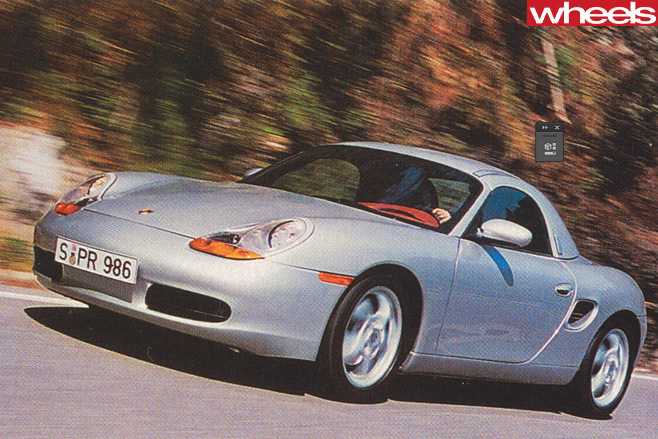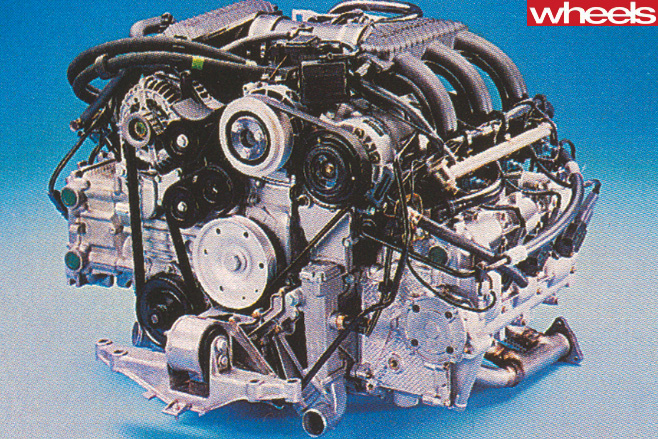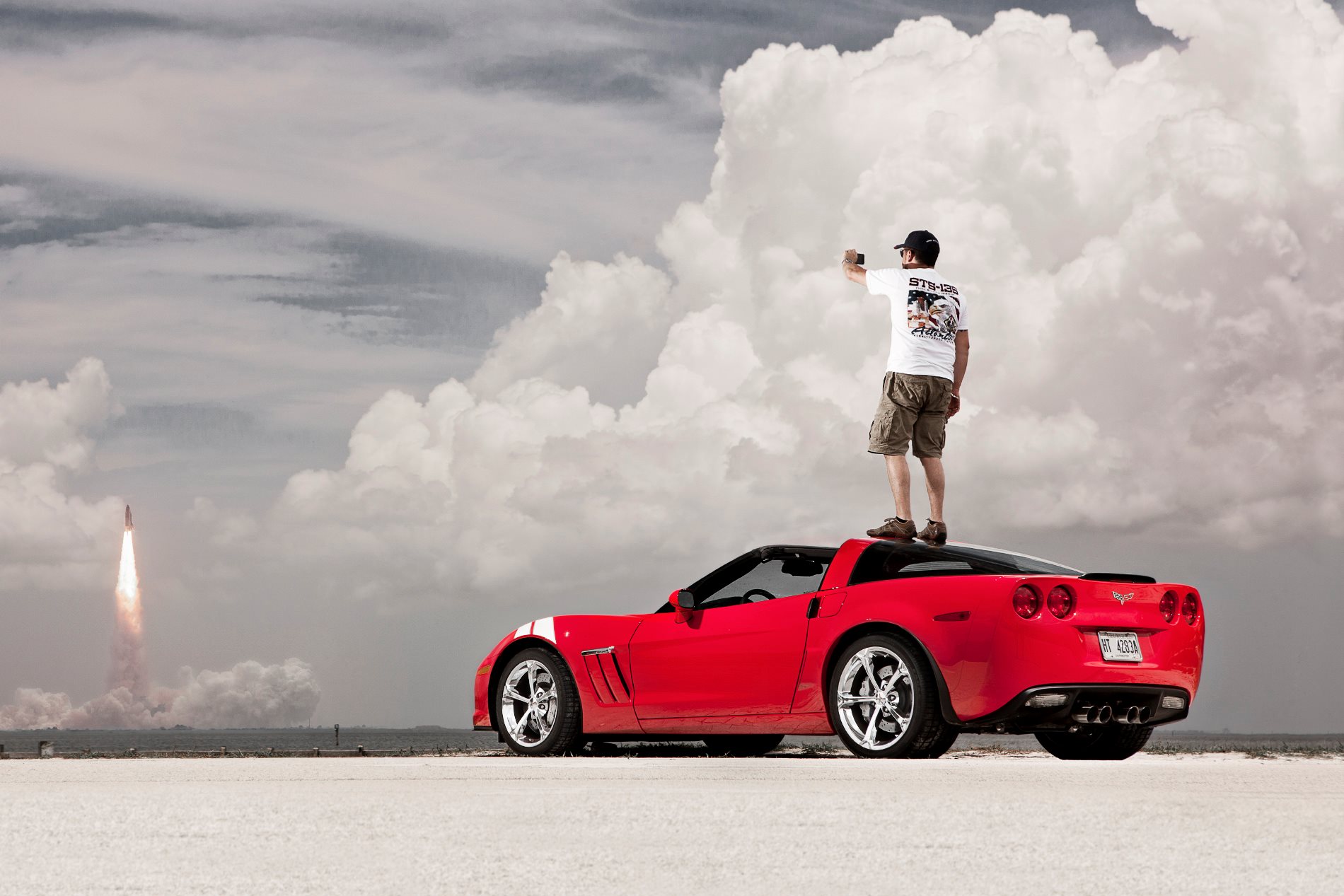It’s official: the Boxster’s as good as we all hoped it would be… perhaps even better, says Peter Robinson.
First published in the October 1996 issue of Wheels magazine, Australia’s most experienced and most trusted car magazine since 1953.
In the end, I gave up.
And God knows I tried, again and again, as the stripes of black rubber firmly embedded onto the road surface of that tight uphill hairpin near Weissach prove.
Yet, no matter what technique I used to attack the corner, nothing could shake loose the tail of Porsche’s incredible new Boxster.
Remember the cliché about cars cornering on rails? The Boxster does.
Photographers insist on power oversteer cornering shots because editors love to run them b-i-g.
Well, Mr Editor MacKenzie, I want you to know that despite my best efforts, neither braking desperately hard right at the apex, nor deliberately booting the car off line in second, could upset the Boxster.

Every corner is an event, every drive, no matter how short, an affair to savour.
This awareness, the knowledge that Porsche’s engineers, free at last to start with a blank sheet of paper, have focused on giving the Boxster true excitement, to create a tactile link between car and driver, lifts it above all the obvious rivals. No Porsche before has so effortlessly, so precisely and intensely, engaged the driver without demanding either great skill or any nagging doubts about its predictability near the limit, or both.
The point is, we can all stop worrying. The Boxster is all Porsche, all sports car, and quite simply, bloody marvellous. At once, Porsche has given us the most dynamic and exciting of all the new generation two-seater roadsters.
Trust the rapid enthusiasts from Porsche’s legendary Weissach R&D centre to place the three high-profile German rivals in the correct perspective: the BMW Z3, soft, as affordable as it is immature; the SLK, so civilised it’s hedonistic, the twoseater you buy your mistress; the Boxster, pure, taut, sparkling with desirability, the roadster for Wheels readers. That shouldn’t come as a surprise, of course, for the Boxster is a bespoke sports car and not a roadster created from a donor sedan.
Yes, the Boxster is everything you would hope for in the first truly new Porsche road car in 19 years. Nothing about its midengined layout, MacPherson strut suspension and water-cooled boxer engine is truly revolutionary, but neither are they owed to the 911, nor indeed the 968 or 928. In fact, this is one of those rare new from- the-ground-up designs, making the 40-month design-freeze-to-public announcement development time all the more impressive.
Nor, as predicted by some, is the production Boxster a disappointing dilution of the beautiful Boxster concept car Porsche unveiled at the 1993 Detroit motor show. Enticing as that showpiece was, it lacked any luggage space, didn’t possess a roof, and wouldn’t pass then-current crash tests, let alone forthcoming side impact and head protection standards.

These dimensions make the Boxster slightly longer and wider than the current Carrera. Not surprisingly, next year’s 996 replacement for the 911 is going to be longer and wider again, to provide better than 2+2 seating.
Porsche had no intention of making the Boxster anything but a pure two seater. The cabin, incredibly roomy and superbly finished, with carpet running halfway up the doors, positions the driver’s seat, steering wheel and pedals in perfect alignment, something no previous Porsche has ever achieved.
However, pragmatic Porsches are one thing; where the Boxster really needs to deliver is on the road. And it does … brilliantly, as I’ve already tried to convey.
At first the messages were confusing: driving away from Weissach, the Boxster was subdued, relaxed, refined. It didn’t sound like a Porsche. Not yet. Only a long and clumsy clutch travel attempted to spoil the perception of civility, while the throttle lacked the instant, gutsy responses of the 968. This new engine, always tractable and silky smooth, needs/loves to spin out beyond 4000rpm to the 6600rpm redline, if it’s to deliver the performance promised by the sleek styling.

You’ll never get a chance to see this beauty, not unless you visit the local dealer and examine the Boxster from below, when it’s on a hoist, for there’s no removable engine cover at all. A small service bay in the rear trunk allows fuel levels to be checked and replenished.
In terms of performance, the Boxster easily accounts for the Z3 and SLK, yet its appeal goes way beyond the 6.9sec 0-100km/h acceleration (7 .4 for the now five-speed Tiptronic with steering wheel button controls) and a 240km/h top speed. There is an eagerness, a real enthusiasm about the Boxster neither rival can match. As the slightly retro-style tacho needle – directly in front of the driver, just like the 911 -spins above the gauge’s simple ‘4’, the engine comes alive. At 5200rpm, it delivers a passionate howl (not unlike the Honda NS-X), hurls the car forward, to aurally kick again with a even deeper wail at 6000rpm. It’s the sound of a fanatically eager engine, trumpeting its own justification for the $109,995 entry fee. Maybe it’s never quite as quick as it feels, but that’s no bad thing in these days of ever more intrusive speed limits.

Low weight helps. At 1250kg, the Boxster’s around 75kg lighter than the less powerful SLK. Of course, that’s partly because it doesn’t have a folding steel roof, but also explained by the use of exotic materials: magnesium roll bars, aluminium engine, suspension and brakes (and for the optional, fully-lined 25kg hardtop), and lightweight steels for the body.
The weight is carefully balanced with 48 percent over the front wheels, despite the mid-engine location; a rather more naturally helpful distribution than the Carrera’s 37/63 balance. Packaging constraints lead to the use of MacPherson struts with lower control arms front and rear, rather than the 911’s double wishbones that were originally developed for the stillborn 989 four door. The suspension is designed to provide negative toe-in at the outer front wheel and positive toe-in at the outer rear wheel to improve stability and encourage understeer.
Rack and pinion, power-assisted steering gives 3.0 turns lock to lock, half a tum more than the 911. But its 1.2m tighter turning circle means the Boxster’s steering is actually quicker. Light by previous Porsche standards, especially at low speed, the steering provides the driver with constant feedback. It might not quite match the Lotus Elise’s direct mechanical link between wheel and road, but it’s surely as good as a superbly developed power steering system can be.

You can dive deep into a tight second gear comer, back off, hit the brakes and the Boxster doesn’t deviate offline. Yet, it is also infinitely adjustable to power applications and close to being truly neutral in its handling character; its responses to the wheel and the throttle happening instantly, as if linked by some unseen mechanical device.
Massive monoblock cast calipers, each with four pistons acting on vented discs, and with ABS 5 anti-lock, give a positive pedal feel and staggering stopping power. Porsche says the Boxster can stop from 100km/h in 2.7sec, or just 37.7m, and from 160km/h in 4.3sec. You could drive the Boxster and never know from its smoothly honed shape that it has any aerodynamic aids. Yet there’s a small lip, positioned between the rear lid and bumper that automatically rises 80nm1 when speeds climb above 120km/h, returning to its concealed position at 80km/h. Fortunately, it can be raised via a button on the front wheel arch, so it’s not an instant giveaway to a speeding fine.
Not only is the Boxster slippery – Porsche claims the 0.31 Cd sets a record for a roadster – but a near smooth underbody reduces lift on the front axle by 36 percent and directs air to the engine.
Sturdy windscreen pillars help the twin integral rollbars provide protection in the event of a roll-over, though 911 drivers will inm1ediately be aware they are much thicker than their car’s thin A-pillars. Harm Lagaay’s team has carefully sculptured the front wings to be clearly visible from the driver’s seat. They flow in towards the centre of the car and provide a subtle visual link with the 911. There’s another link: the ignition key is located on the dashboard, to the outside of the steering column. Even the shape of the side window harks back to the ’50s Speedster. Porsche understands its heritage without being dominated by it.

Flaws: ‘the rear luggage compartment isn’t sufficiently insulated from the engine heat and gets very hot; the central console looks more suited to the controls of a Japanese hi-fi system than a car (surely there’s an alternative to the shiny black finish of these rocker switches and the matching headlight control); compared to the obvious thoughtful design that has gone into the instruments, the dashboard is boringly flat and undistinguished in front of the passenger; the clumsy clutch action; and, to some, the slightly awkward looking side cooling vents (one for the engine compartment, the other for the induction system) that detract a little from the carefully crafted cleanliness of the flanks.
The Boxster, then, is a proper Porsche, a return to the company’s original philosophies, wrapped in an entirely contemporary package. No other roadster offers the same dazzling blend of performance, handling, ride and refinement. Yes, it is dynamically superior to the classic 911, if not quite as quick.
It might not have been this way. The engineers wondered about a front engined replacement for the 944/968, but eventually decided real Porsches use a boxer engine, located somewhere behind the driver. The Boxster is dazzling evidence they were right.
I can hardly wait for another drive, to see if I can keep both photographer and editor happy and learn how, on dry roads, to sling the Boxster sideways.





